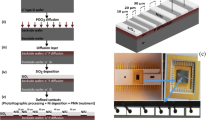Abstract
To improve the thermal stability of the conventional nickel monosilicide, 10 nm-Ni/l nm-Ir/p-Si(100) (or poly-crystalline Si) was thermally annealed using rapid thermal annealing for 40 s at 300–1200°C. The annealed bilayer structure developed into Ni(Ir)Si, and the resulting changes in sheet resistance, microstructure, and composition were investigated using a four-point probe, a scanning electron microscope, a field ion beam, an X-ray diffractometer, and an Auger electron spectroscope. The final thickness of Ni(Ir)Six formed on single crystal silicon was approximately 40 nm, and it maintained a sheet resistance of below 20 ω/sq. during the silicidation annealing at 1200°C. The silicide formed on polysilicon had a thickness of 55 nm, and its low resistance was maintained up to 850°C. An additional annealing of silicides at 900°C for 30 min. resulted in a drastic increase in sheet resistance. A possible reason for the improved thermal stability of the silicides formed on single crystal silicion substrate is the role of iridium in preventing NiSi2 transformation. Iridium also improved the thermal stability of the silicides formed on the polysilicon gate, but this enhancement was lessened due to the formation of NiIrSix and also as a result of silicon mixing during high temperature diffusion. In conclusion, the proposed iridium-inserted nickel silicides may be superior to the conventional nickel monosilicides due to improved thermal stability.
Similar content being viewed by others
References
R. Lindsay, A. Lauwers, M. de Potter, N. Roelandts, C. Vrancken, and K. Maex,Microelectron. Eng. 55, 157 (2001).
International Technology Road Map for Semiconductor, 2003 ed., p. 25, SIA, Front End Process (2003).
E. G. Colgan, J. P. Gambino, and Q. Z. Hong,Mater. Sci. Eng. 16, 43 (1996).
J. Prokop, C. E. Zybill, and S. Veprek,Thin Solid Films 359, 39 (2000).
C. Detavernier, R. L. van Meirhaeghe, and F. Cardon,J. Appl. Phys. 88, 133 (2000).
Hua. Fang, Mehmet C. Ozturk, E. G. Seebauer, and D. E. Batchelor,J. Electrochem. Soc. 146, 4240 (1999).
J. Lutze, G. Scott, and M. Manley,IEEE Electron Device Lett. 21, 155 (2000).
J. B. Lasky, J. S. Nakos, O. J. Cain, and P. J. Geiss,IEEE. Trans. Electron Devices 38, 262 (1991).
B. A. Julies, D. Knoesen, R. Pretorius, and D. Adams,Thin Solids Films 347, 201 (1999).
M. C. Poon, C. H. Ho, F. Deng, S. S. Lau, and H. Wong,Microelectronics Reliability 38, 1495 (1998).
C. Lavoie, F. M. d'Heurle, C. Detavemier, and C. Cabral Jr.,Microelectronic Engineering 70, 144 (2003).
S. H. Cheong and O. S. Song,Kor. J. Mater. Res. 13, 279 (2003).
W. Huang, L. C. Zhang, Y. Z. Gao, and H. Y. Jin,Micro-electronic Engineering 83, 345 (2006).
A. Lauwers, A. Steegen, M. de-Potter, R. Lindsay, A. Satta, H. Bender, and K. Maex,J. Vac. Sci. Technology B 19, 2026 (2001).
D. X. Xu, S. R. Das, J. P. McCaffrey, C. J. Peters, and L. E. Erickson,Mater. Res. Soc. Symp. 402, 59 (1996).
M. Y. Wang, C. W. Chang, C. M. Wu, C. T. Lin, C. H. Hsieh, W. S. Shue, and M. S. LiangVLSI Technology Dig., 153 (2003).
R. Kurt, W. Pitscheke, A. Heinrich, H. Griesmann, J. Schumann, and K. Wetzig,17th International Conference on Thermoelectrics, p. 249–252, IEEE 98 TH, Nagoya, Japan (1998).
Author information
Authors and Affiliations
Corresponding author
Rights and permissions
About this article
Cite this article
Song, O., Yoon, K. Properties of iridium-inserted nickel silicides by thermal annealing of the Ni/Ir bilayer on silicon and polysilicon substrates. Met. Mater. Int. 13, 229–234 (2007). https://doi.org/10.1007/BF03027810
Issue Date:
DOI: https://doi.org/10.1007/BF03027810



